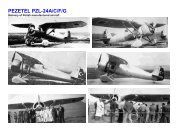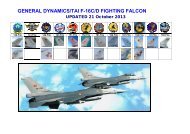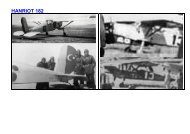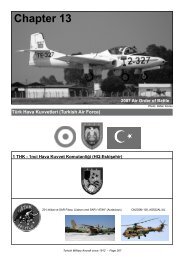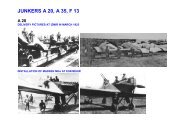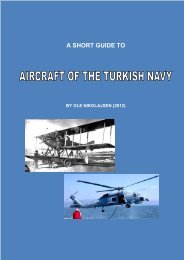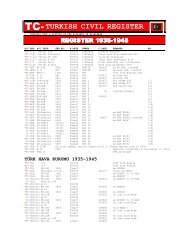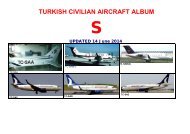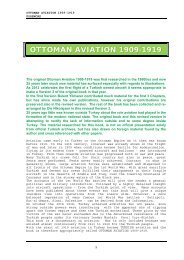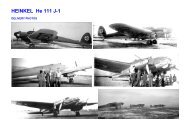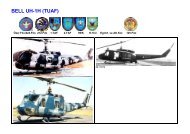danish aircraft manufacture - Ole Nikolajsen
danish aircraft manufacture - Ole Nikolajsen
danish aircraft manufacture - Ole Nikolajsen
Create successful ePaper yourself
Turn your PDF publications into a flip-book with our unique Google optimized e-Paper software.
DANISH<br />
AIRCRAFT MANUFACTURE<br />
Military <strong>aircraft</strong> construction and production is as old as aviation in Denmark. In the early stages of<br />
aviation it was not difficult to construct airframes from scratch as both materials and craftsmen were<br />
readily available. Woodworkers, carriage makers, sail makers and watchmakers could quite easily<br />
make what was necessary. The crucial engine was another matter and the construction of reliable<br />
engines continue to plaque early military aviation in Denmark as elsewhere.<br />
The first <strong>aircraft</strong> constructor in Denmark was J.C.H. Ellehammer who was also the first European to<br />
fly an <strong>aircraft</strong> heavier than air by making a flying hop of 42 meters (on 12.September 1906) in his own<br />
constructed <strong>aircraft</strong> powered by the world’s first (self-designed) radial engine. Later in 1912 he also<br />
flew Europe’s first helicopter. Ellehammer built only <strong>aircraft</strong> for his own use and tests, but a 80 HP<br />
radial engine was evaluated by the navy in 1916 without being accepted.<br />
Several copies of French Farman models later to be used by the armed forces saw the light during<br />
1910-11 (1 used by the Navy), but the first Danish <strong>aircraft</strong> designed was the Berg & Storm Monoplan<br />
which was used in late 1911 to train the first Danish Army aviators. It had a 40 HP air-cooled Danish<br />
designed engine (it is preserved at Tøjhusmuseet in Copenhagen).<br />
A major reason for <strong>aircraft</strong> <strong>manufacture</strong> in Denmark was the inability of the two newly established<br />
military aviation forces the Navy Flying Service (25 March 1912) and the Army Flying Troops (2 July<br />
1912) in obtaining suitable equipment after the outbreak of the 1 st World War in September 1914.<br />
Until the late nineteen-thirties with exception of four <strong>aircraft</strong> (2 Farman Jabiru and 2 Fokker F.XII built<br />
by Orlogsværftet) the Danish <strong>aircraft</strong> production became a military one. Until 1940 about three<br />
hundred military <strong>aircraft</strong> were delivered mostly based licences acquired in England, Germany and The<br />
Netherlands. It says something about the rivalry of the two forces that after the construction of the H-<br />
Maskine in 1917-18 only the Avro 504K and the D.H.60G/M could be agreed upon to serve both<br />
services, and they were NOT built in Denmark!<br />
Manufacturers covered in this account<br />
Burmeister & Wain Shipyards (Berg & Storm) (1909-1911)<br />
Orlogsværftet Flyvemaskineværksted (1913-1943)<br />
Tøjhusværkstederne (1915-24), Flyverkorpsets Værksteder (1924-32)<br />
Flyvertroppernes Værksteder” (1932-1943)<br />
1
Manufacturers covered in separate articles<br />
A/S Nielsen & Winther-Aeroplanafdeling (1916- summer 1919)<br />
Rohrbach Metal Aeroplan Co. A/S (1922-1928)<br />
Cub Aircraft Co. Ltd (1937-1940)<br />
Skandinavisk Aero Industri A/S S.A.I. (Kramme & Zeuthen)<br />
Burmeister & Wain Shipyards (Berg & Storm)<br />
(1909-1911)<br />
The Berg & Storm <strong>aircraft</strong> were designed by the two engineers R. Berg and L. Storm both working for<br />
the Danish shipbuilding and diesel engine company “Burmeister & Wain” (the first to build a diesel<br />
powered ship) who let them use the workshops to fabricate the parts and later assembled it at the<br />
Refshaleøen facility (at Copenhagen harbour), initially a 35HP Anzani engine was used, but later an<br />
air-cooled 40HP engine was used constructed by N. Petersen (also known as the “Engine Doctor). So<br />
one would call the company “Burmeister & Wain” the first Danish <strong>aircraft</strong> company. It didn’t last long,<br />
however, as no <strong>aircraft</strong> was built after the BS III.(in 1911)<br />
Orlogsværftet Flyvemaskineværksted<br />
(1913-1943)<br />
2
A first real concentrated <strong>aircraft</strong> construction was initiated by the Naval Shipyards in 1914. The Navy<br />
had acquired two Donnet-Leveque Flying boats in 1913 which soon showed to have a disappointing<br />
performance. Consequently a new wing was designed as well as other improvements which resulted<br />
in overall amazing improvements of performance.<br />
This became the start of Orlogsværftets Flyvemaskineværksted (The airplane construction shop<br />
of the Naval Shipyards)<br />
Left: Orlogsværftets Flyvemaskineværksted in 1920.<br />
Right:Seaplane station Copenhagen in the early thirties.<br />
which got the distinction of being the second <strong>aircraft</strong> company in Denmark. Encouraged by this a<br />
totally new construction was made of a new type of flying boats retaining the new wing but with a new<br />
slimmer fuselage with the 2 crew members in tandem instead of side by side seating. The first of<br />
altogether 8 <strong>aircraft</strong> powered by imported 80 HP Gnome engines, was test flown on 26.September<br />
1914. They were kept in service until 1919. Later this type received the type designation F.B.II (Flying<br />
Boat type 2). The success of these flying boats resulted in a whole series of similar outlook, but<br />
varying in size and engine power (F.B.II-V) with a total of 25 <strong>aircraft</strong> built. Although the Navy was<br />
satisfied with its small flying boats their sea going characteristics were not the best. A German<br />
Friedrichshafen F.F. 29 floatplane (293) which in 1917 had become stranded in Denmark was The<br />
Construction of early floatplanes and flying boats<br />
impressed, measured and a copy was <strong>manufacture</strong>d (called Mågen 17). Tests were now made<br />
between flying boats and floatplanes and these fell out to the advantage of the floatplanes.<br />
Subsequently four more copies were made under the designation H.B.I (Hydro Biplane 1). Initially they<br />
used 160HP Curtiss engines or 150HP Benz engines, but in 1921 they all got a newly designed<br />
160HP called O.V.160 engine developed in house of which 18 were <strong>manufacture</strong>d. They proved<br />
excellent engines and they were not withdrawn until 1931.<br />
Initially Orlogsværftet Flyvemaskineværksted concentrated on keeping the flying boats and<br />
floatplanes flyable and took over seven German Friedrichshafen F.F. 49 floatplanes which had been<br />
procured by the Ministry of Interior affairs for post flying. When the initial test for this was over the<br />
<strong>aircraft</strong> were given to the Navy. Named H.B.II they were re-conditioned, an 8mm machine-gun and a<br />
Telefunken radio installed. Already in 1919 the Navy had bought, in an obscure deal, a single Hansa-<br />
Brandenburg W 29 <strong>aircraft</strong> and from 1921 onwards it was measured and drawings for a production<br />
made. In the years 1921-25 13 of these <strong>aircraft</strong> were built and in 1927 another 2. All were equipped<br />
with the reliable O.V.160 engine. The <strong>aircraft</strong> also got new pontoons with aluminum skinning. After this<br />
only foreign designed <strong>aircraft</strong> have been built by Orlogsværftet. In 1920 the Navy had procured 6 Avro<br />
504K trainers to be followed by a single Avro 504N in 1925, a modernized version with a 180HP Lynx<br />
engine. Orlogsværftet from 1926-29 build three 504Ns under license and two of the older 504K were<br />
updated to N standard. The <strong>aircraft</strong> were given the type designation L.B.I the first land based <strong>aircraft</strong> of<br />
the service.<br />
3
After the “Marinens Flyvevæsen” on 7.August 1922 became an independent unit under the Navy the<br />
next major event was in 1925 with the designation of the workshops as a separate Section under<br />
Orlogsværftet called “Flyvemaskineafdelingen” (the Aeroplane Section) having its own Manager. At<br />
The construction of the H.M.I<br />
the same time it was realized that the workshops had an over capacity and a contract was in 1925<br />
signed with “Det Danske Luftfartsselskab” (DDL now a part of SAS) for the building of two Farman<br />
Jabiru 4-engined 9 passenger airliners under license. The <strong>aircraft</strong> delivered in 1926, however, was an<br />
ill-concepted design (of no fault of Orlogsværftet) and was taken out of service already in 1929. By<br />
1925 Marinens Flyvevæsen had realized that in the future they needed land based fighters as the<br />
floatplanes could not take the stresses of air fights. Having had good experience with the business of<br />
the Avro 504s an English type was selected, a Hawker fighter later named “Dankok”(Danecock)<br />
powered by an Armstrong Siddeley Jaguar engine (in reality a well known double Lynx engine with two<br />
cylinder rows). New for the navy was oxygen mask installation and parachute. Three British built<br />
<strong>aircraft</strong> arrived in 1926 and from 1927 to 28 another 12 given designation L.B.II were built. As a<br />
replacement for the H.M.I a type designed by the same constructor, Ernst Heinkel was chosen, the 2-<br />
seater H.E. 8. The Navy, however required a 3-seater housing a pilot, a radio-operator and an<br />
observer who also manned the rear 8mm machine gun. Besides it was required that the <strong>aircraft</strong> be<br />
powered by a newly designed Armstrong Siddeley Jaguar engine of 460HP with a geared propeller for<br />
increased reliability. This type was the first <strong>aircraft</strong> built by Orlogsværftet which was not made of wood<br />
in that the whole fuselage and undercarriage was made of welded steel tube. In 1928 Heinkel<br />
delivered 6 <strong>aircraft</strong> (He.313-316, 323) and from 1929 to 31 another 13 were built by Orlogsværftet.<br />
Construction of civil airliners<br />
Further in 1938 three more <strong>aircraft</strong> were built as attrition replacements. For Marinens Flyvevæsen the<br />
H.M.II, as the Heinkel was designated became until 1940 the maid of all work for the service.<br />
Hundreds of hours were also flown in opening Greenland up for aviation from 1932-38. With the war<br />
clouds forming in Europe the <strong>aircraft</strong> were camouflaged and tests were made with war time<br />
deployments to small lakes and fjords. After April 9 th 1940 the surviving 13 <strong>aircraft</strong> were stored and<br />
finally sabotaged in October 1943. In 1928 an important change established Marinens Flyvevæsen’s<br />
own maintenance workshops in charge of periodic checks. This new organization also established a<br />
quality control office checking the production at Orlogsværftet. Since the latter did not design <strong>aircraft</strong><br />
engines any more all testing and maintenance of engines went to the new organization.<br />
The experience made with the welding of the fuselage of the H.M.II came into good use when<br />
Orlogsværftet in 1933 and 1935 made two Fokker F.XII 3-engined airliners for DDL.As a replacement<br />
for the Dankok fighter the Navy in 1933 bought two Hawker Fury fighters being named Nimrod in<br />
Danish service, with 525HP Rolls-Royce Kestrel IIIS engines. Designated L.B.V the new fighter was<br />
given a larger fuel capacity and as something new for the navy a radiotelephone for the pilot. With a<br />
license to built the type 10 <strong>aircraft</strong> were made from 1934-35. Once more the workshops had to change<br />
procedures as the fighters were made of steel tube being riveted together. After the Navy had bought<br />
three Avro Tutor trainers (L.B.IV) in 1932 a further three were built under<br />
4
O.V. Constructions<br />
Avro 504N H.E.8 Avro Tutor<br />
Avro Tutor<br />
Hawker Dankok<br />
Hawker Nimrod<br />
The last types constructed by the O.V. Hawker Nimrod and Fairey P.4/34<br />
license by Orlogsværftet one in 1935 and two in 1937. Both the Nimrods and the Tutors were in<br />
service when Germany invaded Denmark in 1940 and their fate was equal to the H.M.IIs.<br />
In the late thirties Denmark was almost desperately trying to renew its military <strong>aircraft</strong> fleet and a<br />
committee established. Without buying a prototype or pattern <strong>aircraft</strong> a contract was signed for the<br />
license building of 12 Fairey P.4/34 two-seat reconnaissance/bomber <strong>aircraft</strong> powered by a single<br />
1030HP Rolls-Royce Merlin II engine (almost a look a like to the ill-fated Fairey Battle bomber and<br />
developed further into the Navy’s successful Fulmar shipboard bomber). The <strong>aircraft</strong> displayed for the<br />
time a very powerful armament of one 20mm fixed canon and four forward firing 8mm machineguns<br />
and well as a moving rearward firing 8mm machinegun. Again something new was introduced to the<br />
workshop that of a monocoque aluminum construction. The project made it necessary the building of a<br />
new assembly hall at Copenhagen Naval Air Station and the fabrication of parts started in late 1938.<br />
Given the designation L.M. I as the first monoplane land based <strong>aircraft</strong> of the Navy the <strong>aircraft</strong> got the<br />
O.V.building numbers 93-104, but none were completed before April 9 th 1940. The new assembly hall<br />
served a storage place for all the Navy’s <strong>aircraft</strong> until they were destroyed in 1943.<br />
A recent photo of Copenhagen Naval Aviation Station<br />
5
Tøjhusværkstederne (1915-24)<br />
Flyverkorpsets Værksteder (1924-32)<br />
Flyvertroppernes Værksteder” (1932-1943)<br />
The Army had in June 1912 received the B & S Monoplan as a gift and this was placed in a rented<br />
hangar at Kløvermarken airfield just outside Copenhagen. For the maintenance of the <strong>aircraft</strong> a well<br />
known aviator and mechanic was hired and under them served the army aviators and a small number<br />
of tradesmen from the Army’s Tøjhusværkstederne (Depot). By 1915 the staff was 15, but during the<br />
next 3 years this increased to the ten-fold. The first <strong>aircraft</strong> to be constructed was the D.K. I (Danish<br />
Konstruction 1) a 2-seat Farman look-a- like first flown 8 June 1916. It was not a good design and after<br />
it crashed 2 months later the engine (70 HP Renault) was used to power a (reverse engineered)<br />
Maurice Farman (plane no.2) . Meanwhile, however, D.K.II a one-seater had already flown on March<br />
10, 1916 (plane no.3). Then things happened fast and in 1916 three more Maurice Farmans were<br />
started upon and the Army obtained a license right to build 12 Vickers F.B.5’s which were started upon<br />
in the spring. The first F.B.5 was completed in April 1917. Unfortunately, the from England supplied<br />
100HP Gnome Monosaupape engines were very unreliable and although the Gunbus was a well flying<br />
airplane it was flown little and they were grounded in April 1919. The lack of suitable powerful engines<br />
hampered the design of new types and it was first at the end of 1916 progress was made with the<br />
permission to buy nine 140HP Argus engines in Germany. In collaboration with Orlogsværftet a twoseat<br />
reconnaissance <strong>aircraft</strong> for the army named H-Maskine (after H in Danish Hær=Army). The first of<br />
these flew in July 1918. Orlogsværftet built 4 and Tøjhusværkstederne 5 of these <strong>aircraft</strong> which<br />
unfortunately were grounded after the April 1919 law which stopped flying with unreliable engines (the<br />
Argus engines came under this). They were scrapped in 1924.<br />
Army <strong>aircraft</strong> construction<br />
Fokker C V recce <strong>aircraft</strong> and O-Maskiner under construction at the Flyvertroppernes Værksteder”<br />
It was first by the new defense law in 1922 that an within the Army an independent “Hærens<br />
Flyverkorps” (Army Flying Corps) on 1.February 1923 was established. Consequently in 1924 the<br />
previous Tøjhusværkstederne was subordinated under it with the name “Flyverkorpsets<br />
Værksteder” (The workshops of the Flying Corps) with the task of providing maintenance and building<br />
of new equipment. Initially a German L.V.G. B III <strong>aircraft</strong> was copied in two examples, before in 1924<br />
personnel from the workshops went to the Netherlands for by Fokker to learn to make <strong>aircraft</strong> their<br />
way, fuselage of welded steel tube and wings of wood (the Army workshops were less used to welding<br />
than the personnel at the Navy shipyard!). Two Fokker C.I trainers were bought and with those as<br />
pattern <strong>aircraft</strong> 3 more examples (F.V.31-33) with 160HP Mercedes engines were built in 1925.<br />
Meanwhile the Fokker C V had been selected as the Army’s future reconnaissance <strong>aircraft</strong> (it later<br />
served as such until the German occupation in 1940) and five with 400HP Lorraine engines were<br />
6
initially bought from Fokker. A license for building an additional 7 <strong>aircraft</strong> was obtained. From 1927-29<br />
those seven <strong>aircraft</strong> were built as a combined effort with Fokker, who delivered the fuselages and<br />
Flyverkorpsets Værksteder who delivered the wings and assembled the <strong>aircraft</strong>. Then in 1931 six<br />
more <strong>aircraft</strong> (F.V.49-54) were built solely by the Danish workshops. From 1929 onwards the Lorraine<br />
engines were replaced with Bristol Jupiter 440HP engines both in the already built ones and the new.<br />
In between this Cpt. C. Førslev (later Commander of the Air Force) had developed the design of the C<br />
I into a basic trainer named “O-Maskine” (after Overgang = transformation) with a 220HP BMW<br />
engine. The prototype flew first in 1926 and in 1928-29 14 additional <strong>aircraft</strong> were built (F.V.34-48).<br />
Later in 1932-33 a new single-seater version with a 160HP Mercedes engine was constructed in 8<br />
examples. It is amazing to note that in the time 1925-30 31 <strong>aircraft</strong> were built by a staff of only 65.<br />
Meanwhile Fokker had made a new version of the C V with a new undercarriage and the more<br />
powerful Bristol Pegasus 550HP engine. The license agreement was changed to include this version<br />
and a test <strong>aircraft</strong>, with initially a four bladed propeller, was delivered from Fokker in 1933. From 1934-<br />
35 23 (F.V.63-85) of this version were built and the old versions were modernized. Since 1932 when a<br />
new defense law was implemented the workshops had changed name to “Flyvertroppernes<br />
Værksteder” as the flying service had changed name to “Hærens Flyvertropper”. A C V named III R<br />
(R-49) in Danish service was the only Danish <strong>aircraft</strong> shot down in the German attack on Denmark on<br />
April 9 th 1940, both crew members were killed.<br />
(as an epilog: The Danish C Vs were stored and impressed by Luftwaffe. Some or all were deployed<br />
as light attack <strong>aircraft</strong> on the Eastern front by Estonian cooperative forces in the unit N.S.Gr.11<br />
carrying the codes 3W+O. In the autumn 1944 two 3W+OL ex.R-42, 3W+OD ex.R-23) with Estonian<br />
crews escaped to Sweden, here they were later scrapped as after the war the Danish military had no<br />
interest in the <strong>aircraft</strong>).<br />
The new defense law stipulated an inventory of 2 fighter squadrons for which the army could only<br />
muster four Bristol Bulldog fighters having been procured in 1931. As those were quickly proven behind<br />
current developments another British type, the Gloster Gauntlet biplane fighter with a 605HP Bristol<br />
Mercury engine, was chosen as its replacement. Meanwhile the workshops had come to get used to the<br />
British construction methods of the time, a skeleton of steel tubes riveted together with a multitude of<br />
small metal plates covered with canvas. They were thus well prepared for the new challenge. One<br />
Gauntlet (K4081) was delivered on-covered in 1935 and from 1936 to 38 17 <strong>aircraft</strong><br />
Above: The Gloster Gauntlet fighters during final assembly.<br />
Below: The relatively modern Fokker D.XXI was the newest <strong>aircraft</strong> build <strong>aircraft</strong> by the Army.<br />
were <strong>manufacture</strong>d (F.V.86-102). The Gauntlet fighters had been difficult to built, with no less than<br />
3200 technical drawings needed, so it was welcomed when the Army decided to order for its second<br />
fighter squadron a “normal” Fokker construction as its first monoplane fighter. The Fokker D.XXI with a<br />
825HP Bristol Mercury engine was built in 10 units from 1939 to 40. The Danish army was not<br />
satisfied with the armament so it was decided to equip the fighter with 2 Danish Madsen 20mm canons<br />
in gondolas under the wings, a work which was not finished on the 9 th of April. Four <strong>aircraft</strong> were<br />
written of in the German attack on Værløse Air base and it has been revealed that the six survivors<br />
were in 1944 used by Luftwaffe by “Sonstigen Einheiten” until withdrawn in August 1944. The next<br />
project was the building of the Fokker G. I reconnaissance-bomber. In 1939 personnel went on training<br />
7
with Fokker and a series of 12 <strong>aircraft</strong> was started. At this time the works had been hugely enlarged by<br />
the new workshops at Værløse Air base covering 6500m2 in addition to the old facilities at<br />
Kløvermarken which had grown to 3000m2, the workforce had grown to 175 workers and 20 staff. The<br />
G I’s were planned to be delivered in August 1941, but building stopped after April 1940. After the<br />
German invasion the Danish Army and Navy remained in uniform and their <strong>aircraft</strong> went into storage<br />
under Danish control. In order to keep flying proficiency the two services were allowed to practice<br />
glider flying. For this purpose Flyvertroppernes Værksteder in 1941 built five S.G.38 gliders and in<br />
1942 four Grunau Baby IIB’s. The last of these received building number HFV 123 the last ever to be<br />
built by the workshops as they were sabotaged both in 1943 and 44.<br />
Left:“Flyverkorpsets Værksteder” in the early thirties.<br />
Right:The new facilities at Værløse build in 1938.<br />
During and after the war “Skandinavisk Aero Industri-SAI” see separate story became the <strong>aircraft</strong><br />
company in Denmark which has produced most <strong>aircraft</strong> (186)<br />
However, In 1963 SAI stopped its <strong>aircraft</strong> business and moved from its hangar in Copenhagen Airport.<br />
At the same time the rights to the designs, tools and spare parts were sold to Scanaviation. Thus after<br />
having built 186 <strong>aircraft</strong> of own design <strong>aircraft</strong> construction, apart from hobby design and building<br />
came to a halt in Denmark.<br />
Værløse Army Aviation base and works in the late thirties<br />
8
List of <strong>manufacture</strong>d <strong>aircraft</strong>:<br />
Burmeister & Wain Shipyards (Berg & Storm) (1909-1911) (3 <strong>aircraft</strong>)<br />
B&S I (1) 1909 for civil use<br />
B&S II (1) 1911for civil use B&S III (1) 1911<br />
Orlogsværftet Flyvemaskineværksted (1913-1943) (96+12 not finished)<br />
F.B. II (8) 1914 (O.V.1,2,4,5,8,10,14,19)<br />
F.B. III (10) 1915-1917 (O.V.3,6,7,9,11,13,16-18,20)<br />
F.B. IV (3) 1917-1918 (O.V.15,21,23) Friedrichshafen F.F.29 (copy of <strong>aircraft</strong>) (1) 1917 (O.V.12)<br />
F.B. V (3) 1919 (O.V.26,28,29) H-Maskine (constructed and partly built for the Army)(4) 1918<br />
9
H.B. I (4) 1918-1919 (O.V.22,24,25,27)<br />
H.M.I (Hansa-Brandenburg W29 copy)(15) 1922-27 (O.V.30-42, 51,52)<br />
L.B. I (Avro 504N license/copy) (3+2 rebuilt Avro 504K) 1925-1926 (O.V.43,49,50)<br />
Farman Jabiru (2) for civil use 1926 (O.V.44,45)<br />
L.B. II Dankok (Hawker Danecock license)(12) 1927-1928 (O.V.46-48, 53-61)<br />
10
H.M. II (Heinkel H.E.8 license) (13+3) 1929-1931, 1938 (O.V.62-74, 90-92)<br />
Fokker F.XII (License) (2) for civil use 1933-1935 (O.V.75,87)<br />
L.B. V (Hawker Nimrod license)(10) 1934-1935 (O.V.76-85)<br />
L.B. IV (Avro Tutor license) (3) 1935-1937 (O.V.86,87,89)<br />
L.M. I (Fairey P.4/34 license)(12 not completed) 1938-1940 (O.V.93-104)<br />
Below : The O.V. J-1 fighter project.<br />
11
Tøjhusværkstederne (1915-24), Flyverkorpsets Værksteder (1924-32)<br />
Flyvertroppernes Værksteder” (1932-1943) (124+12 not finished)<br />
D.K.I (1) 1916 (D.K.1)<br />
D.K.II (1) 1916 (D.K.2)<br />
Vickers F.B.5 (License)(12) 1917 (T.V.1-12)<br />
L.V.G. B III (Copy) (4) 1920-1926 (L.V.G.2-5)<br />
H-Maskine (Designed by Orlogsværftet)(5) 1918 (H.1-9)<br />
Fokker C.I (License)(3) 1925 (F.V.31-33)<br />
12
I O-Maskine (14) 1926-1929 (F.V.34-48)<br />
II O-Maskine (8) 1932-1935 (F.V.55-62)<br />
I R (Fokker C V M/26 license)(7+6) 1927-1930, 1931 (F.V.49-54)<br />
II R, (Fokker C V M/33 license)(11) 1934 (F.V.63-73)<br />
III R (Fokker C V M/33 license)(12) 1935 (F.V.74-85)<br />
13
II J (Gloster Gauntlet license)(17) 1936-1938 (F.V.86-102)<br />
III J (Fokker D. XXI license)(10) 1939-1940 (F.V103-112)<br />
(IV R) (Fokker G. I license not completed) (12) 1939-(1941)<br />
S.G.38 School gliders (5) 1941 (HFV 115-119) Grunau Baby gliders (4+5 for civil use) 1942, 1943<br />
(HFV 120-123)<br />
14



